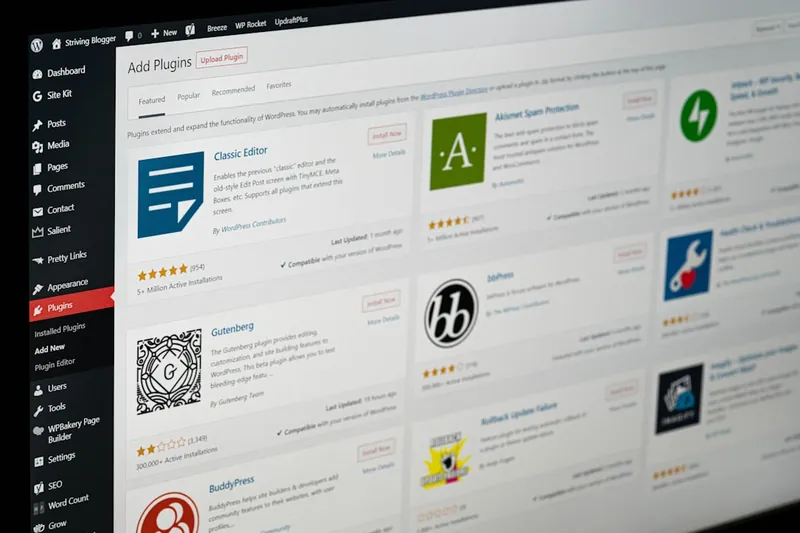
What is a Good Title for a Blog?
A good blog post title is like a first impression at a job interview – you only get one shot to make it count. In today’s fast-paced digital world, where readers are bombarded with countless content options, your blog title serves as the gateway to your carefully crafted content. But what exactly makes a title “good” enough to stand out in the crowded digital landscape?
Let’s dive into the essential elements that make a blog title truly effective and click-worthy.
The Anatomy of an Effective Blog Title
A good blog title combines several key elements that work together to capture attention and drive engagement. Here are the fundamental characteristics:
- Clarity and Specificity: Your title should clearly communicate what readers will gain from your content
- Emotional Appeal: It should trigger curiosity, excitement, or other emotional responses
- Length Optimization: Typically between 50-60 characters for optimal display in search results
- Keywords Integration: Natural inclusion of relevant search terms
- Promise of Value: Clear indication of the benefit readers will receive
Research shows that titles containing numbers, such as “7 Proven Ways” or “5 Essential Tips,” can increase click-through rates by up to 36%. Additionally, titles that ask questions have been found to generate 23% more engagement than declarative statements.
Common Title Formulas That Work
While creativity is important, certain tried-and-tested formulas consistently deliver results:
- “How to [Achieve Desired Outcome] in [Timeframe]”
- “[Number] Ways to [Solve Common Problem]”
- “The Ultimate Guide to [Topic]”
- “Why [Common Belief] Is Wrong (And What to Do Instead)”
- “[Number] Secrets of [Desired Achievement] That Experts Won’t Tell You”
Remember, while these formulas provide a solid foundation, they should be customized to your specific topic and audience. The best titles often combine multiple elements – for example, “7 Unexpected Ways to Boost Your Productivity in Just 15 Minutes a Day” incorporates numbers, specificity, and a clear time commitment.
When crafting your blog title, always consider your target audience’s search intent and pain points. A good title addresses these directly while maintaining authenticity and avoiding clickbait tactics that could damage your credibility. The click-worthy formula isn’t just about getting clicks – it’s about delivering on the promise your title makes.
As we move forward in understanding how to create irresistible blog post titles, it’s crucial to remember that testing and refinement are key components of success. What works for one audience might not work for another, so don’t be afraid to experiment with different approaches while staying true to these fundamental principles.

How Do You Name a Blog Post?
Crafting the perfect blog post title is both an art and a science. It’s often the determining factor between a click and a scroll-past, making it one of the most crucial elements of your content strategy. Let’s dive into the proven methods for creating titles that not only capture attention but also drive engagement.
The Anatomy of an Irresistible Blog Title
When considering how to name a blog post, start by understanding the key components that make titles click-worthy. The most effective blog titles typically include:
- A strong primary keyword for SEO purposes
- An emotional trigger word or phrase
- A clear value proposition
- Numbers or specific data when applicable
- A sense of urgency or curiosity
Proven Formulas That Work
Research shows that certain title structures consistently perform better than others. Here are some time-tested formulas you can use:
- “How to [Achieve Desired Outcome] in [Timeframe]”
- “[Number] Ways to [Solve Problem] Without [Common Solution]”
- “The Ultimate Guide to [Topic]”
- “What Nobody Tells You About [Topic]”
- “Why [Common Belief] Is Wrong (And What to Do Instead)”
Studies have shown that headlines with numbers can generate 36% more engagement than those without. Additionally, titles that include the word “guide” tend to perform 30% better than average.
Essential Tips for Title Optimization
To maximize the impact of your blog post titles, consider these practical guidelines:
- Keep titles between 50-60 characters for optimal display in search results
- Place important keywords near the beginning
- Use power words that evoke emotion or urgency
- Ensure the title accurately reflects the content
- A/B test different variations to find what works best
Remember, your title is essentially making a promise to your readers. The content must deliver on that promise to maintain credibility and encourage return visits. When implementing the click-worthy formula: secrets to irresistible blog post titles, focus on creating titles that are both compelling and honest.
Common Pitfalls to Avoid
While crafting your titles, be careful to avoid these common mistakes:
- Clickbait tactics that mislead readers
- Overusing buzzwords or jargon
- Being too vague or generic
- Making unrealistic promises
- Keyword stuffing
By following these guidelines and consistently testing different approaches, you’ll develop a keen sense of what titles resonate with your audience. Remember that the perfect title balances SEO requirements with reader appeal, creating that irresistible combination that drives clicks and engagement.

What is the Ideal Blog Post Title for SEO?
Creating the perfect blog post title for SEO is both an art and a science. It requires carefully balancing user engagement with search engine optimization while maintaining clarity and relevance. Let’s dive into what makes a blog post title truly ideal for SEO in today’s digital landscape.
The Anatomy of an SEO-Optimized Title
An ideal blog post title for SEO typically follows several key principles that help it perform well in search results while attracting readers. Here are the essential elements:
- Optimal Length: Keep titles between 50-60 characters to ensure they display properly in search results without getting cut off
- Primary Keyword Placement: Include your target keyword within the first 60 characters, preferably near the beginning
- Clear Intent: Make the purpose and value of your content immediately apparent
- Emotional Triggers: Incorporate power words that evoke curiosity or emotion
Research shows that titles with numbers typically perform 36% better in terms of click-through rates compared to those without. For instance, “7 Proven Ways to Optimize Your Blog Titles” tends to perform better than “How to Optimize Your Blog Titles.”
Formula for Success
The ideal SEO title often follows this winning formula:
[Number or Trigger Word] + [Target Keyword] + [Promise or Benefit] + [Optional Power Word]
For example: “5 Proven SEO Title Strategies That Double Your Traffic Today”
Common Mistakes to Avoid
- Keyword stuffing that makes titles sound unnatural
- Using clickbait tactics that don’t deliver on promises
- Creating titles too long for search results
- Neglecting to include search intent
Remember, while optimizing for search engines is crucial, your title must primarily serve your human readers. Google’s algorithms are increasingly sophisticated at determining user intent and engagement metrics, making authentic, value-driven titles more important than ever.
Testing and Optimization
The best way to determine what works for your audience is through testing. Use tools like Google Search Console to monitor click-through rates and adjust your titles accordingly. A/B testing different title formats can provide valuable insights into what resonates with your specific audience.
As we move forward in our discussion of creating irresistible blog post titles, it’s important to remember that SEO optimization is just one piece of the puzzle. The next crucial element is understanding how to incorporate emotional triggers that compel readers to click through to your content.
Headline Generators & Brainstorming Tools
Coming up with captivating blog post titles doesn’t always have to be a manual brain-wracking process. In today’s digital age, we have access to powerful headline generators and brainstorming tools that can transform your creative process and help you craft irresistible headlines that drive clicks and engagement.

Popular Headline Generation Tools
Several innovative tools have emerged as go-to resources for content creators seeking the perfect headline. Here are some of the most effective options:
- CoSchedule Headline Analyzer: This powerful tool scores your headlines based on word balance, length, and emotional value. It provides detailed insights into your headline’s strength and offers suggestions for improvement.
- Portent’s Content Idea Generator: Known for its creative and sometimes humorous suggestions, this tool helps break through writer’s block by generating unique angles for your topics.
- Answer the Public: While not strictly a headline generator, this tool shows you what questions people are asking about your topic, which can be transformed into compelling headlines.
- HubSpot’s Blog Ideas Generator: Simply input your topic, and it will generate a week’s worth of blog title ideas in seconds.
Brainstorming Techniques for Headlines

While tools are valuable, combining them with proven brainstorming techniques can yield even better results. Consider these effective methods:
- The 25-Headlines Exercise: Write 25 different versions of your headline. The first 10 are usually obvious, the next 10 become more creative, and the final 5 often yield your best options.
- Swipe File Method: Keep a collection of headlines that caught your attention and analyze why they worked. Use these as inspiration for your own titles.
- Mind Mapping: Start with your core topic in the center and branch out with related concepts, emotions, and benefits to generate unique angles.
Research shows that headlines with numbers perform 36% better than those without, and headlines containing emotional words can increase click-through rates by up to 27%. When using headline generators and brainstorming tools, focus on incorporating these elements while maintaining authenticity.
Remember that while these tools provide excellent starting points, the final headline should always align with your content’s value proposition and your audience’s needs. The best practice is to generate multiple options using various tools and techniques, then test them against your target audience’s preferences and behavior patterns.
As you move forward in crafting your click-worthy headlines, remember that these tools are meant to enhance, not replace, your creative process. The most effective headlines often come from combining tool-generated suggestions with your unique understanding of your audience and subject matter.
how long should a blog post title be
The Ideal Length for Blog Post Titles: A Quick Guide
A blog post title should typically be between 50-60 characters (around 6-8 words) to maximize both SEO performance and reader engagement. This length ensures your title appears fully in search engine results without getting cut off, while still being comprehensive enough to convey your post's main topic.
Key considerations for title length:
• Google typically displays the first 50-60 characters in search results
• Social media platforms have varying title display limits
• Mobile devices show fewer characters than desktop views
Pro tip: While staying within the recommended character count, ensure your title includes your primary keyword and creates enough curiosity to encourage clicks. If you must choose between a slightly longer, more descriptive title or a shorter, vague one, opt for clarity over brevity.
Remember: The best title length balances SEO requirements with reader appeal while clearly communicating your content's value.
why is it important to avoid unnatural repetition of words in your blog post title?
Avoiding Unnatural Word Repetition in Blog Titles
Unnatural word repetition in blog titles can harm your content's effectiveness in several important ways. First, it makes your title appear unprofessional and poorly crafted, potentially driving readers away before they even reach your content. Search engines may also view excessive keyword repetition as keyword stuffing, which can negatively impact your SEO rankings.
Pro tip: When crafting titles, use synonyms or related terms instead of repeating the same word. For example, rather than writing "Best Coffee Making Tips for Making Great Coffee," try "Best Coffee Brewing Tips for a Perfect Cup."
Additionally, repetitive titles can make your content appear less authoritative and trustworthy to both readers and search engines. They can also reduce click-through rates as users tend to prefer clear, concise, and naturally worded titles.
Remember: A well-crafted title should flow naturally while incorporating your target keywords thoughtfully and purposefully.
Does blog title affect SEO?
Yes, blog titles significantly impact SEO performance in several important ways. They serve as the H1 heading of your page, which search engines prioritize when determining content relevance. A well-crafted title helps search engines understand your content's topic while attracting potential readers.
Key SEO benefits of optimized blog titles include:
• Higher click-through rates from search results
• Improved keyword relevance signals
• Better content organization for search engines
• Enhanced user engagement metrics
For maximum SEO impact, follow these best practices:
• Include your target keyword near the beginning of the title
• Keep titles between 50-60 characters
• Make them compelling but accurate
• Use numbers or power words when appropriate
Remember: While optimizing for SEO is important, your title should primarily serve your readers by clearly communicating what they'll gain from your content. Balance search engine requirements with user experience for the best results.
Do you capitalize every word in a blog title?
Title Capitalization Rules for Blog Posts
The rules for capitalizing blog titles depend on your chosen style guide, but most blogs follow either AP Style or Chicago Style. Generally, you should capitalize:
• The first and last words
• All major words (nouns, verbs, adjectives, adverbs)
• Words longer than four letters
Don't capitalize:
• Articles (a, an, the)
• Short conjunctions (and, but, or)
• Short prepositions (in, on, to)
Pro tip: When in doubt, use a title capitalization tool like Capitalize My Title or Title Case Converter to ensure consistency across your blog posts.
For SEO purposes, it's more important to write clear, descriptive titles that include your target keywords than to worry excessively about perfect capitalization. Just choose one style guide and stick with it consistently throughout your blog.
Are blog titles copyrighted?
Blog titles generally receive very limited copyright protection. While the entire blog post content is automatically protected by copyright law when published, titles themselves usually fall into a gray area. This is because titles are typically short phrases, and copyright law doesn't protect short phrases, names, or slogans (these might be protected by trademark law instead).
However, if a blog title is particularly creative or unique, it might receive some copyright protection. To stay on the safe side, here's a practical tip: Always create original titles for your blog posts rather than copying exact titles from other sources. This not only avoids potential legal issues but also helps with SEO since unique titles perform better in search results.
In conclusion, while you technically can use the same blog title as someone else, it's best practice to create original titles that reflect your unique content and perspective.
